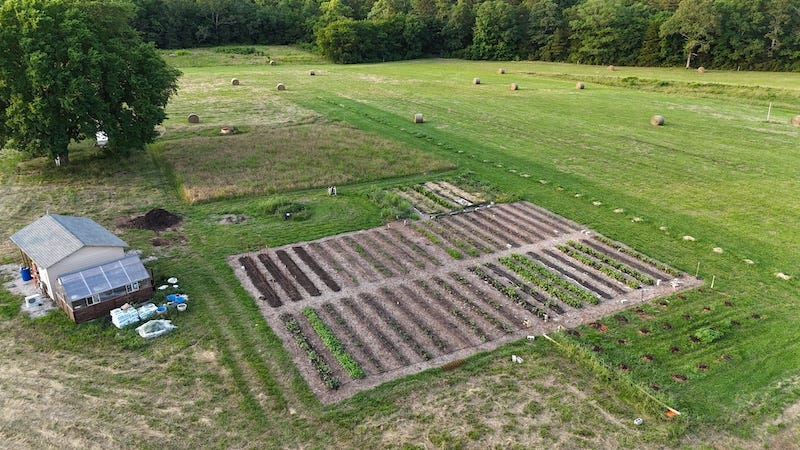Off-Grid Farm Automation with Raspberry Pi
A fully custom, self-hosted system built for real-world farm conditions — sensors, valves, and control logic from the ground up.
Welcome to the PioT Project — a series chronicling how I designed and built a fully custom, self-hosted automation system to run the real-world farm infrastructure at Stella Porta™. It’s powered by Raspberry Pi, written entirely in C and C++, and built from the ground up with zero reliance on cloud services or third-party automation platforms.
From controlling irrigation valves to logging environmental data, every piece is handcrafted: the hardware, the control logic, the REST API, and expandable device plugins. This system is built for dirt, weather, power failures, and the kind of rugged autonomy you can't buy in a box.
If you're new to the series, start here. This post lays the groundwork — what the system is, why it’s custom-built, and how it’s designed to run reliably without cloud services or outside dependencies. The rest of the series dives into the hardware and software in detail.
Farm automation made easy as Pi
01-May-25 — Setting up the foundation for real-world IoT on the farm.
The Hardware
Off-the-shelf just didn’t cut it — much of this system required custom-built solutions, from I²C and 1-Wire interface cards to ruggedized sensor networks and valve drivers that can survive real-world abuse. This section is a deep dive into the tech: how each piece works, why it was built that way, and what it takes to design hardware that holds up to dirt, lightning, and daily farm life.
Controlling the Irrigation Valves
01-May-25 — The basics of switching solenoids, safely and reliably.Reading from the 1-Wire Sensors
06-May-25 — Building the temperature sensing layer.Using the I2C Protocol to Communicate to Sensors
07-May-25 — How we wired it, read it, and filtered out the crap.Reading Environmental Data with I2C
09-May-25 — Expanding the sensor net and interpreting the data.Raindrops Keep Falling On My Head
26-May-25 — Detecting precipitation (and making decisions from it).More I/O
30-May-25 — Handling expansion and GPIO overload.Rolling My Own I²C and 1-Wire Interface Card
21-Jun-25 — A custom hardware solution for real-world reliability.PWM: A Better Way to Control Sprinkler Valves
21-Jul-25 — Fine-tuned voltage control for water flow.Kicking Zeus's ass
18-Aug-25 — Dealing with the fun of rural power spikes and lightning strikes.Smart Power Switch and Shutdown for Raspberry Pi
05-Oct-25 - Battery Backup and controlled shutdown.11-Oct-25 — I2C-Based Linear Actuator Driver with Current Monitor
The Software
I didn’t build the software stack from scratch just for fun — I did it because the system needed to be reliable, modular, and completely independent of third-party cloud services. Written entirely in C/C++, it’s designed to run unattended in real-world conditions, fully under local control. This section walks through the architecture, the REST API, and the logic that makes it all work.
Getting the Data and Controlling the Devices from the REST API
01-Jun-25 — Talking to your Pi from across the network.Writing Your Own Device Plug-ins
03-Jun-25 — Custom code to extend your system’s reach.Using Software Devices to Build on the Hardware
06-Jun-25 — Simulated devices and logic layers.How to Make Things Happen Automatically
07-Jun-25 — Trigger-based actions and logic chains.Time Has Come Today
12-Jun-25 — Scheduled tasks and automation routines.There Are Always Conditions to Evaluate
13-Jun-25 — Conditional logic for smarter systems.Recording and Accessing Environmental Data Remotely
01-Jul-25 — Logging and remote access to your system’s mind.Preventing Injection Attacks to the Database
07-Jul-25 — Keeping bad guys out of your Pi.Why the Raspberry Pi GPIO API is broken and how to fix it
11-Nov-25 - How a quiet change in Linux and libgpiod boned developers
In the works
How I packaged the Raspberry Pi for farm use.
Keeping it secure from hackers.
Building a web-based user interface.
If you’re interested in some background on the farm itself — the place, the people, and the problems that led me to build all this — I’ve written a few companion pieces that give more context. They aren’t as technical as the PioT articles, but they are part of the story. And like everything else here, they’re grounded in the dirt — not in theory.
Distance from Disorder
26-Jun-24 — Why and how we moved to Arkansas.Be Water, My Friend
01-May-24 — Our first irrigation project at Stella Porta.The Great Pumpkin Patch Pump
07-May-24 — Pumpkin Patch Irrigation project.Rural Internet
08-May-24 — Solar-powered Wi-Fi, StarLink, and Cameras.The Guest House
10-May-24 — Southern Hospitality.This is My Dirt
20-May-24 — The Farmsteading Adventure Begins.
If you want to hear me jiber-jabber about this project check out this YouTube Video
Interview with Raspberry Pint
30-Sep-25 - Building resilient systems that don’t need the cloud
Whether you're looking to automate your own homestead, build resilient systems that don’t crumble when the Wi-Fi drops, or just want to see what happens when you give a Raspberry Pi a job and no excuses — this series has something for you. Every post is packed with lessons learned, hard-won reliability, and source code that isn’t afraid of a little dirt. So dig in, fork the repo, and build something that works when the grid doesn’t.
Stay frosty — and stay independent.
— Vinnie


